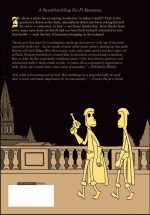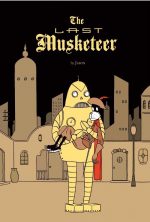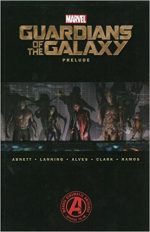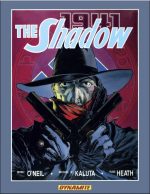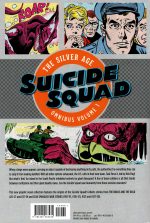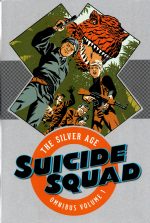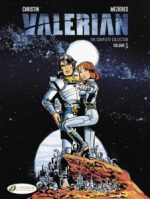
By J.-C. Méziéres & P. Christin with colours by E. Tranlé and translated by Jerome Saincantin (Cinebook)
ISBN: 978-1-84918-352-9
Val̩rian is possibly the most influential science fiction series ever drawn Рand yes, I am including both Buck Rogers and Flash Gordon in that expansive and undoubtedly contentious statement.
Although to a large extent those venerable newspaper strips formed the medium itself, anybody who has seen a Star Wars movie has seen some of Jean-Claude Méziéres & Pierre Christin’s brilliant imaginings which the filmic phenomenon has shamelessly plundered for decades: everything from the look of the Millennium Falcon to Leia’s Slave Girl outfit…
Don’t take my word for it: this splendid oversized hardback compendium – designed to cash in on the epic movie from Luc Besson released this summer – has a copious and good-natured text feature entitled ‘Image Creators’ comparing panels to stills from the films…
In case you were curious, other additional features include the photo and design art-packed ‘Interview Luc Besson, Jean-Claude Méziéres and Pierre Christin (Part I)’ and bullet-point historical lectures ‘How it All Began…’, ‘Go West Young Men!’, ‘Colliding Worlds’, ‘Explore Anything’ and ‘Hello!’ This is Laureline…’
Simply put, more carbon-based lifeforms have experienced and marvelled at the uniquely innovative, grungy, lived-in tech realism and light-hearted swashbuckling roller-coasting of Méziéres & Christin than any other cartoon spacer ever imagined possible.
Valérian: Spatio-Temporal Agent launched in the November 9th 1967 edition of Pilote (#420, running until February 15th 1968). It was an instant hit. However, the graphic album compilations only began with second tale The City of Shifting Waters, as all concerned considered the first yarn as a work-in-progress and not quite up to a preferred standard. You can judge for yourself, as Bad Dreams kicks off this volume, in its first ever English-language translation…
The groundbreaking series followed a Franco-Belgian mini-boom in science fiction triggered by Jean-Claude Forest’s 1962 creation Barbarella. Other notable successes of the era include Greg & Eddy Paape’s Luc Orient and Philippe Druillet’s Lone Sloane adventures, which all – with Valérian – stimulated mass public reception to science fiction and led to the creation of dedicated fantasy periodical Métal Hurlant in 1977.
Valérian and Laureline (as the series eventually became) is a light-hearted, wildly imaginative time-travel adventure-romp (a bit like Doctor Who, but not really at all), drenched in wry, satirical, humanist and political commentary, starring (at least in the beginning) an affable, capable, unimaginative and by-the-book cop tasked with protecting the universal time-lines and counteracting paradoxes caused by casual time-travellers…
The fabulous fun commences with the aforementioned Bad Dreams – which began life as ‘Les Mauvais Rêves – a blend of comedy and adventures as by-the-book time cop Valérian voyages to 11th century France in pursuit of a demented dream-scientist seeking magical secrets to remake the universe to his liking. Sadly, our hero is a little out of his depth but is soon rescued from a tricky situation by the fiery, capable young woman named Laureline.
After handily dealing with the dissident Xombul and his stolen sorceries, Valerian brings Laureline back with him to the 28th century super-citadel and administrative wonderland of Galaxity, capital of a vast and mighty Terran Empire.
The indomitable girl trained as a Spatio-Temporal operative and was soon an apprentice Spatio-Temporal Agent accompanying Val on his missions throughout time and space…
Every subsequent Val̩rian adventure Рuntil the 13th Рwas first serialised in weekly Pilote until the conclusion of The Rage of Hypsis (January 1st-September 1st 1985) after which the mind-bending sagas were simply launched as all-new complete graphic novels, until the magnificent opus concluded in 2010.
(One clarifying note: in the canon “Hypsis†is counted as the twelfth tale, due to the collected albums being numbered from The City of Shifting Waters. When Bad Dreams was finally released in a collected edition in 1983 it was given the number #0.)
The City of Shifting Waters was originally published in two tranches; ‘La Cité des Eaux Mouvantes’ (#455 25th July to 468, 24th October 1968) and followed by ‘Terre en Flammes’ (Earth in Flames, #492-505, 10th April to 10th July 1969).
Both are included in this compilation and the action opens here with the odd couple dispatched to 1986 – when civilisation on Earth was destroyed due to ecological negligence and political chicanery and atomic holocaust – to recapture Xombul, still determined to undermine Galaxity and establish himself as Dictator of the Universe.
To attain his goal the renegade has travelled to New York after a nuclear accident has melted the ice caps and flooded the metropolis – and most of everywhere else. He is hunting hidden scientific secrets that will allow him to conquer the devastated planet and prevent the Terran Empire from ever forming… at least that’s what his Galaxity pursuers believe…
Plunged back into an apocalyptic nightmare where Broadway and Wall Street are under water, jungle vines connect the deserted skyscrapers, Tsunamis are an hourly hazard and bold looters are snatching up the last golden treasures of a lost civilisation, the S-T agents find unique allies to preserve the proper past, but are constantly thwarted by Xombul who has built his own deadly robotic slaves to ensure his schemes.
Visually spectacular, mind-bogglingly ingenious and steeped in delightful in-jokes (the utterly-mad-yet-brilliant boffin who helps them is a hilarious dead ringer for Jerry Lewis in the 1963 film The Nutty Professor) this is still a timelessly witty delight of Science Fiction which closes on a moody cliffhanger…
Rapidly following, Earth in Flames concludes the saga as our heroes head inland and encounter hardy survivors of the holocaust. Enduring more hardships they escape even greater catastrophes such as the eruption of the super-volcano under Yellowstone Park before finally frustrating the plans of the most ambitious mass-killer in all of history… and as Spatio-Temporal Agents they should know…
Concluding this first fantastic festive celebration is The Empire of a Thousand Planets which originally ran in Pilote #520-541(October 23rd 1969 to March 19th 1970) and saw the veteran and rookie despatched to the fabled planet Syrte the Magnificent, capital of a vast system-wide civilisation and a world in inexplicable and rapid technological and social decline.
The mission is one of threat-assessment: staying in their base time-period (October 2720) the pair are tasked with examining the first galactic civilisation ever discovered that has never experienced any human contact or contamination, but as usual, events don’t go according to plan…
Despite easily blending into a culture with a thousand separate sentient species, Valerian and Laureline find themselves plunged into intrigue and dire danger when the acquisitive girl buys an old watch in the market.
Nobody on Syrte knows what it is since all the creatures of this civilisation have an innate, infallible time-sense, but the gaudy bauble soon attracts the attention of one of the Enlightened – a sinister cult of masked mystics who have the ear of the Emperor and a stranglehold on all technologies….
The Enlightened are responsible for the stagnation within this once-vital interplanetary colossus and they quickly move to eradicate the Spatio-Temporal agents. Narrowly escaping doom, the pair reluctantly experience the staggering natural wonders and perils of the wilds beyond the capital city before dutifully returning to retrieve their docked spaceship.
However, our dauntless duo are distracted and embroiled in a deadly rebellion fomented by the Commercial Traders Guild. Infiltrating the awesome palace of the puppet-Emperor and exploring the mysterious outer planets, Valerian and Laureline discover a long-fomenting plot to destroy Earth – a world supposedly unknown to anyone in this Millennial Empire…
All-out war looms and the Enlightened’s incredible connection to post-Atomic disaster Earth is astonishingly revealed just as interstellar conflict erupts between rebels and Imperial forces, with our heroes forced to fully abandon their neutrality and take up arms to save two civilisations a universe apart yet inextricably linked…
Comfortingly, yet unjustly, familiar this spectacular space-opera is fun-filled, action-packed, visually breathtaking and mind-bogglingly ingenious.
Drenched in wide-eyed fantasy wonderment, science fiction adventures have never been better than this.
© Dargaud Paris, 2016 by Christin, Méziéres & Tranlệ. All rights reserved. English translation © 2016 Cinebook Ltd.




